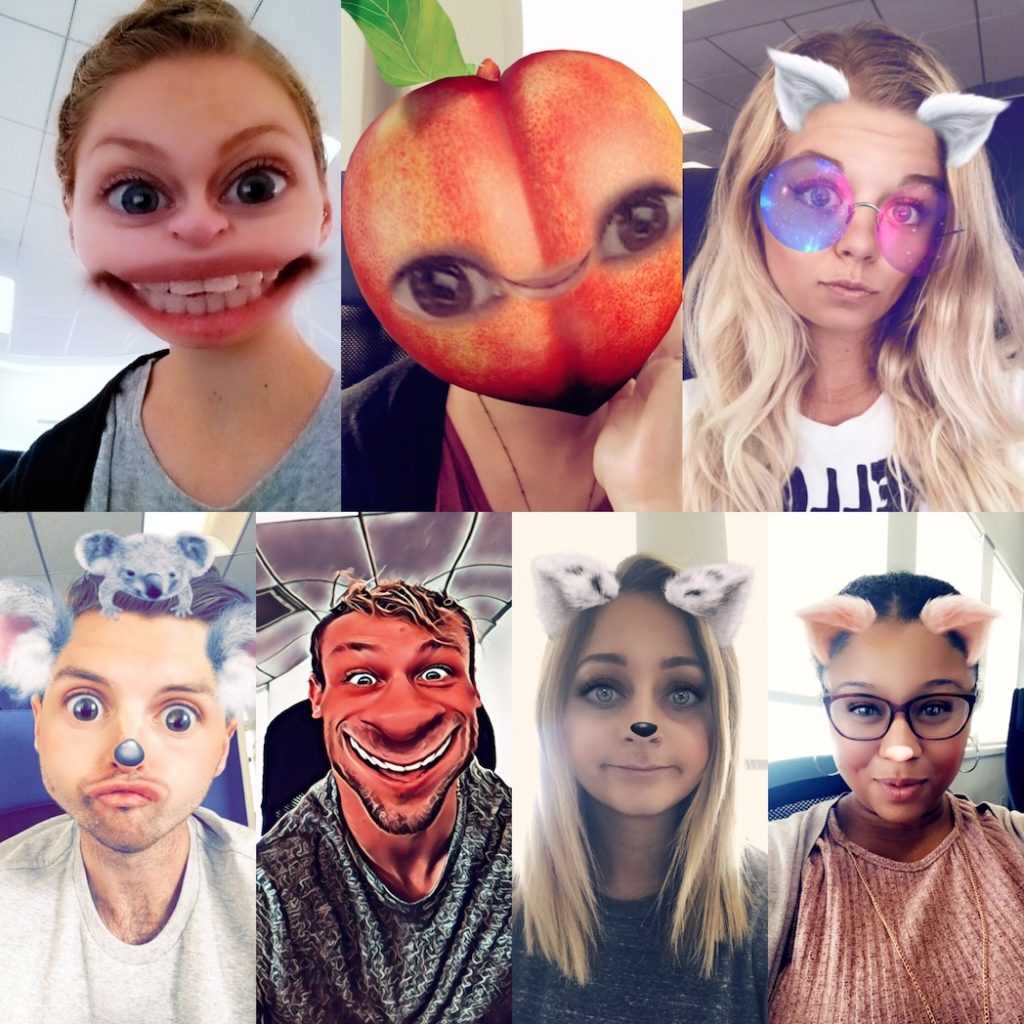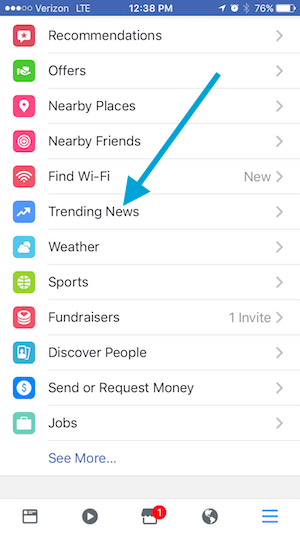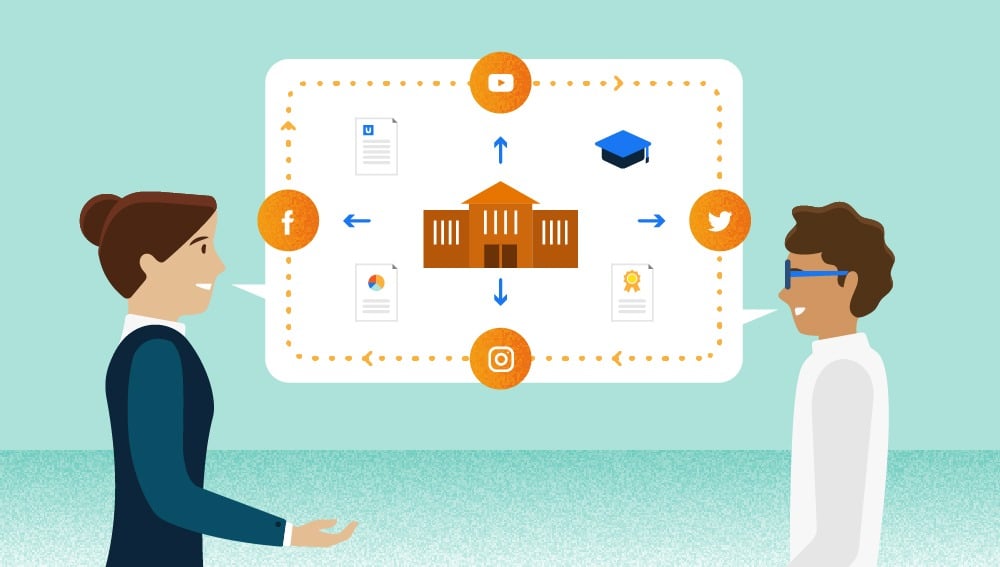There are currently 2.8 billion social media users worldwide. This means that over a third of the world’s population is using some form of social media to communicate, making social media marketing an imperative tactic for boosting leads for higher education programs. While social media is a commonplace platform for communication today, have you ever considered how significantly social media changed the way we communicate?
Our world as we know it has transformed from the start of text messages to the first years of Facebook, to today’s temporary stories. But how has social media changed society and what does this mean for higher education marketing? Let’s look at what each of the most used social platforms has contributed to our new way of communication and how you can utilize them in your higher education marketing campaigns.
The Top Social Media Platforms Changing Communication
Facebook is seen as the most predominant social media platform and it has the numbers to back it up.

With 2.01 billion monthly users, and 88 percent of 18-29-year-olds using this platform, Facebook should always be a top priority for higher education marketers. Facebook is a pioneer in today’s social world. Allowing people to connect with anybody, from their best friends to distant relatives, as well as share their personal thoughts, pictures, videos, blogs, and links. The addition of Facebook Chatbots has also opened up a whole new world in customer service and digital marketing.
Learn more: Adding Facebook Chatbots to Your Social Media Strategy
Twitter is a fast-paced network that allows users to share information instantaneously –– in 140 characters or less.

With 328 million monthly users, and 36 percent of 18-29-year-olds using this platform, it can seem like the next best way to reach potential students. However, consider that nearly 79% of Twitter accounts are located outside of the United States. If this doesn’t affect your digital marketing strategy, then Twitter can still be a lucrative platform. Just remember that the most important aspect of marketing on Twitter is the hashtag. Don’t know how to find the best hashtags to get your content seen by your targeted audience? Try TrendsMap or Keyhole for real-time tracking by industry and locale.
Snapchat has led the way in “temporary” social media, allowing users to share content that can only be seen for 24 hours at most.

This social media is only available through a mobile app and boasts roughly 166 million daily users. If you don’t believe Snapchat is worth your university’s time, consider the fact that 56 percent of 18–29-year-olds use Snapchat daily. This app is designed for tech-savvy and content-hungry users. In other words, Snapchat is the perfect application to reach millennials, especially for universities looking to share a different side of their campus and boost interest in their brand. If you’re looking to learn more about using social media to drive university branding check out this post.
This Facebook-owned, social media platform has doubled its user base to 700 million monthly active users in just two years.

How did they do it? By creating a Snapchat clone all their own. Instagram is hugely popular among younger generations, with 59% of 18-29-year-olds using the app. To grab their attention, Instagram created similar features for their stories, like filters and stickers, but implemented them in their own unique way. Thanks to a social media-savvy audience and visual platform, Instagram Stories has become an integral part of this social media app. Along with announcing its first anniversary, Instagram Stories now has 250 million daily users (Stories alone is surpassing Snapchat’s 166 million daily users). Want to capture more student leads using Instagram Stories? Check out this article.
Now, enough with the statistics. The most important thing to understand is that no matter what platform you look at, social media as a whole has informed and shaped millennial culture through gifs, sound bites, chats, brief moments, and temporary flashes of content. Let’s take a look at how all of these social media thrills are affecting the way we communicate.
How Social Media Changed the Way We Communicate
1. Created a Sense of Urgency and a Need to Share ?
Since its launch in 2004, Facebook has created a place to share anything from genius shower thoughts to favorite songs. The catch is: are you sharing too little or too much?
Social media platforms like Facebook and Twitter have manifested the need to constantly broadcast our lives on the internet. Twitter is most famous for this after becoming known for celebrities sharing what they ate that day or if they were tweeting from the bathroom. After this oversharing trend faded, social media became a bit more tolerable for the average user. From then on, nobody could avoid Aunt Vicky’s vacation photos or Kim Kardashian’s famous behind “breaking the internet“. The need to share and be shared has grown immensely. Fast forward to today’s most used social media apps, and you will discover the type of sharing we do today is much different.
In basic communication, humans transmit information and receive instant feedback. The integration of texting, messaging, and emailing, however, has enabled senders and receivers to sit and dwell before responding. Instagram Stories and Snapchat have changed the game by making messages and content available to view for only 24 hours. To remember what was said, or seen, and reply appropriately, the user must reply as soon as they’ve opened it. In effect, these temporary messages take away the ability to dwell and create a more real-time form of communication.
Social media has created a way for people to constantly update and share content with their friends with little effort. Whether it is posted forever on a timeline or a couple of seconds in a Snap, a picture is worth a thousand words and social media has created the perfect medium to share these visual stories with friends.
2. Provided an Inside Perspective of Faraway Places ?
Social media has enabled people from all over the world to share their stories. Besides the internet essentially connecting the world, Snapchat was the first to really give people an inside perspective of foreign places. With the addition of live story streams and Story Explorer, users can get a peek of what life in other cities, states, and countries is like. Snapchat in particular regularly features cities from around the world and features them on the app with a live feed of Snapchats from people in the selected city. For example, tapping on the “Rio” feed instantly transports users to the lively city in Brazil and provides a peek at life through the eyes of everyday citizens.
Besides cities, live feeds are perfect for sharing events. This is the ideal platform to share student events, football games, community outreaches, and more from a higher education perspective. Snapchat provides universities the unique opportunity of sharing experiences with a wide array of the campus population. By utilizing a live feed, or a Snapchat account altogether, a university is now able to show prospective students what campus life is like from a student’s point of view. The students who Snapchat their experiences are nurturing their connection to the university and sharing student stories on Snapchat can result in higher student interest, and help prospective students to determine if a school is a right fit for them.
More on: Using an SEO audit to drive results.
3. Shared the Full Story, Instead of Just Highlights ?
It has already been a year since both Snapchat and Instagram announced the next generation of storytelling: Memories and Stories. These social media channels enable users to not just share the best picture out of their daily experiences; it encourages them to share the full story. Through Instagram, Facebook, AND Snapchat stories many users channel their creativity to share their day from the moment they wake up, to the moment they go to sleep.
Instead of uploading a few photos on Facebook or posting a 140 character tweet on Twitter, universities can utilize Snapchat and Instagram to complete their “social story”. A university can share a campus event from beginning to end using a mix of video and pictures. A great example would be using Snapchat to share a graduation weekend with their audience. The university can share captured moments of graduates and the ceremony, award banquets, speeches, and more. By sharing moments in this way, a university can create a sense of community and become relatable to current and prospective students.
4. Made Digital Messages More Personal ?
Customizing content doesn’t just mean choosing how long a picture can be viewed or writing a caption to accompany the picture. Snapchat and Instagram have taken storytelling to the next level by encouraging users to draw, write, sticker, and filter their pictures to add a personal touch and have fun doing it! The newest Snapchat and Instagram feature enables users to interact with the content they view and share.
Both Snapchat and Instagram have upgraded the average selfie. Now users can transform into a myriad of animals, characters, and even other people using these smart filters. The most popular example of a filter would be Taco Bell’s Cinco de Mayo filter that transformed users into actual tacos. Taco Bell was able to market, create brand awareness, and even set a new record by using Snapchat’s features to engage and interact with their customers.

A university could create a Snapchat filter for a football game that would engage students in attendance and encourage them to share their stadium experience. By creating an interactive university brand, prospective students are shown the campus community and current students will feel more engaged and a part of their school’s conversation.
Snapchat’s Discover features channels for a group of brands to broadcast their own content. These brands are lucky enough to be able to market themselves by engaging their audience and creating a conversation through interactive content. Another ability users have when using Discover is being able to directly share their favorite pieces of content with their Snapchat friends. Instead of explaining and describing what was so funny, simply holding a finger on the screen allows users to instantly show their friends why they are laughing.
5. Brought News Back into Millennial Life ?
All of this interactive content has to lead to journalism becoming attractive to millennials again. A study conducted by Wibbitz found that 40 percent of millennials rely on digital outlets for their news, while 23 percent primarily get their news from social media. Snapchat jumped on this finding and added news outlets to Discover.
An overarching theme in this article is interaction. Millennials love to interact with content, so why not the news? A big step in this new territory occurred when the Wall Street Journal joined Snapchat. CNN and National Geographic are among the 24 other media companies that have also joined the application in hopes of delivering journalistic content to this demographic.
Besides Snapchat, Facebook and Twitter have also played important roles in making the news more accessible and attractive to millennials. Twitter features “trending” hashtags that often highlight important national and global events. The website and app also highlight an array of news updates, events, and hot topics through the “What’s Happening” portion of their landing page. Facebook also joined the journalistic movement by creating their own “Trending” section that highlights trending stories ranging from politics to science and technology. Facebook has taken this movement one step further and just debuted a section specifically for Trending News on its mobile app.

6. Provided the Ability to Broadcast Moments –– Live ?
Facebook Live became available to the public in April 2016 and instantly changed social media as we know it. At first, it began as a way to innocently share even more with your friends, but then it became increasingly used for serious matters. Facebook Live has ended up revealing a lot about our society, from police shootings to a look at the increasing rate of opioid overdose deaths. On the positive side, it has created a launchpad for these more serious conversations to be had. Thanks to these Facebook Live videos, these controversial moments are not just being talked about but also building momentum behind creating a positive change.
Besides changing the way we communicate major events through video, Facebook and Instagram Live have also opened up new marketing potential for universities. Similar to how a university can utilize Snapchat and Instagram Stories, higher education marketers can use the Live feature to engage both current and potential customers by sharing university events in real-time! Live allows your audience to jump right into graduation, special concert, or collegiate event and get a real sense of what campus life is like from a student’s point of view.
Today’s social media has undeniably transformed our means of communication, created new opportunities for brands and universities, and even brought personality back into the digital world.
